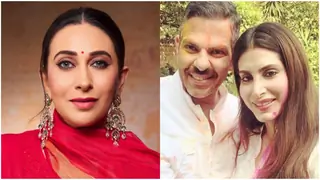Originally posted by: skanda12
Abhay:
First of all hats off to you for so beautifully collecting and presenting this information! I loved it!👏
Regarding your 4 questions, this is my view:
1. The importance of women in that era: I think from what I see (from you research and from the serial irself etc), the Mughals were more advanced in using women as a whole in political positions and in their daily life and celebrations. The corresponding Hindu kingdoms, they have had a few strong examples of women in power, but I am talking of women as a whole.
The average Mughal women seems to have had more liberty than the average Hindu ruled kingdom women.
But there again we may have to check if women were used as "lucky charms:" or as partners and companions of standing and with brains. Some cultures, for example, used women as "lucky charms" I am told ... which actually denigrates their status, because although they are present everywhere, their value is perceived to be less about their "brains" being valuable and they are used more as figureheads for celebrations, events, pre-war prayers etc.
I would use "brains" as a yaerdstick of judgement. If women were valued for their brains and thinking etc then they were well used. If they were used more for their "beauty" or "luck" etc. then I would think they were ill-used.
2. The miniature paintings of the Mughals definitely pack more detail than the minitaures of the other kigdoms of the West that I have seen so far. Also here the King seems the subject more, whereas in the Western areai miniatures, Krishna and the Gods and their life depictions seems to be more widespread.
3. I am aghast that we have allowed the British to not only take away our treasures but also to distribute them to all and sundry later. This is abominable. Whay can I say?😡
4. If I am not mistaken the Mughals descended from the Genghis Khan ancestry, which may be the reason why they had a lot of land-locked kingdom management expertise, but the Navy was a relatively newish thing for them perhaps after conquering vast parts of India especially the east and west coasts. But they must have developed skills because it was later given somewhere that Jodha herself was given control of the ships that carried Haj pilgrims. Is this correct? If Jodha, a lady, were given control of ships, then the ship and seafaring must have been more prevalent for Navy use, because only after Navy requirements would they have built more ships for trade or pilgrimages etc?
Hope my guesses have been more or less accurate?
Thnx Mansi,
All point -> Well Said..!!!..👏
You have given an elaborate reply. I am not getting enough words to answer this.
For point 1Yes, ladies were given importance, in that time also. One should never go ONLY by generally accepted norms. There are examples which say so. In
Mughals take the example of:
Haji Begum / Bega Begum
Maham Anga,😉😆
Hamida Banu Begum
Mariam-Uz-Zamani Begum
Ruqayya Begum
Salima Begum
Nur Jahan,
Jahanara Begum,
Zinnat-un-Nissa Begum, etc.
Infact, this
prosperity is well-intact till the time,
empire flourishes. Basically, i mean to say, that
political security ensures other developments also.😊 And,
Mughals had a
secure and powerful empire atleast from
Akbar's time to end of
Aurangzeb.(
1556-1707).
The concept of Economy and Empire goes together.😊So,
when their
empire had the
strength to
fight other
rivals. In the
meantime the
women folk contributed a lot to
other developments.
Coming to
other Hindu kingdoms, majority of North-West India was under
continuous attack from the West Asians. And, wars did create security issues for womenfolk. So, since
political stability was missing from this area. Hence, it was sure that in this area, the time which women get for their personal own deveelopments/experiments would be less. But, inspite of this, these areas also have examples, like:
Mira Bai,
Rani Durgawati (a great warrior.
She fought against this same Asaf Khan in the battle in 1564 while fighting in Garh area, of central India, and finally finding surrounded by enemy, stabbed herself. It is recorded for her that, she used to drink water, only after
killing the tiger, if she heard the voice of this beast.🤓 Commanded the army, herself in the battle-field, since her husband had died long before, and had defeated surrounding rulers also, including Baz Bahadur of Malwa.)
Note:Asaf Khan = Adham Khan ( hope you understood what i mean, from the above episode.😕)Rani Padmavati (a LIVING legend in Chittor .!. Commited Jauhar in 1303-5 around. There is mention about her in Padmavat by Malik Muhammed Jayasi.)
As per my reading in especially Rajputana history, there is mention that
court ladies were capable of composing
excellent verses in
Sanskrit and
Prakrit language.
Contrary to popular opinion, the princesses of Rajput aristocracy were skilled in
fine arts,😉 specially in
paintings and
dancing. They had the right to inherit the property of their male relations, after their death. Also, contrary to popular belief,
Sati was NOT practiced in each case. It depended on other factors as well. Example: Take the case of
Rajmata Bala Bai, grandmother of Jodha, from serial.😉
Many foreign scholars have written total rubbish about them.🤬
Note: I have not written many contributions about the Mughal ladies in this comment
deliberately.😉 They will be posted separately by an other member.😊
Also, we were discussing about
aristocracy, here.
Point 2Actually, it's not possible to compare the miniatures of different kingdoms. 😊 Because these are influenced by the location of the
seat of governance, and ofcourse the religious beliefs, etc.
Also, it is a general perception that the rulers apart from Mughals did not have well developed painting art, but that is not the entire story.😊 Separate schools of paintings existed in Rajputana also, like
Mewar, Bundi, Kishangarh, Jaipur, Bikaner, Kota, Pahari, Kangra and Basholi.
Of these the
Jaipur paintings are close to Mughals.(got the connection.?.?.😉.)
And,
Kangra and
Basholi closely resemble Mughal miniatures.😊
About
Mughal paintings we know, as this thread started from this topic only. But, would mention,
Akbar had 17 main painters. Out of them,
NOT less than 13 were Hindu painters ONLY.😉
Point 3Even i sail in same ship. Many of the Indian artifacts are in these foreign museums and they are not in public domain. 😕
Point 4You are almost on the point here also.😊 Since, Mughals never faced sea-warfare considering their ancestry as they had to fight on land, so it was natural that INITIALLY they appeared uninterested in sea-warfare. But, as you also mentioned regarding
Jodha and Haj ships, etc. It was clear that protection was meted out to these ships also.😊 But, the point is that,
special warfare ships were not on their agenda. Also, it seems that the
protection was not up to the mark, because these ships were at times
captured by the Portuguese. 😕
As you guessed, they built ships later, but NOT for warfare.😊
Shah Jahan, in 1651, initiated construction of 4 to 6 BIG ships, but for
voyages to West Asia. In following year, 6 ships were put into commission. Soon, Indian shipyards were in a position to produce ships based on European models.
One thing worth mentioning is that, the
Armed Land Might of Mughals at that time compensated for their lack of warfare at sea level. 😊
BTW,
Tipu Sultan(1782-99), is said to have started a programme for such warfare ships,
quietly.😉
P.S. -> Made this reply post in phases. 😆Typing 3-4 lines at a time, while taking a break of 5-10 minutes, from my schedule.🥱
@All. I will reply to posts, but slowly.!.Meanwhile, keep posting.
I like reading your views.😊


































20